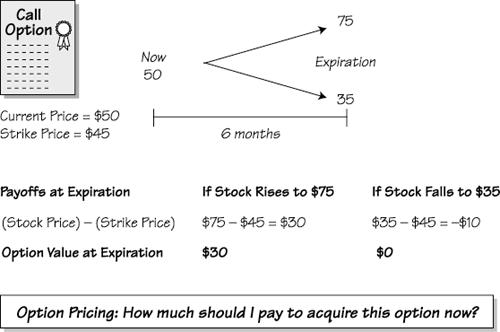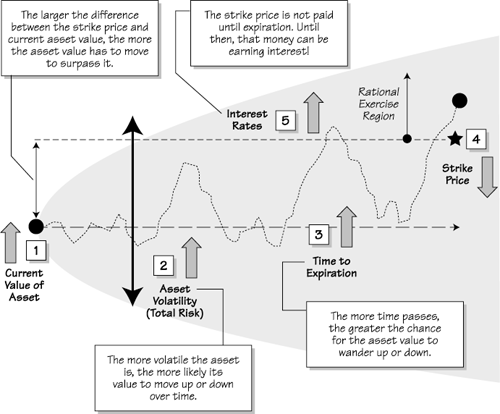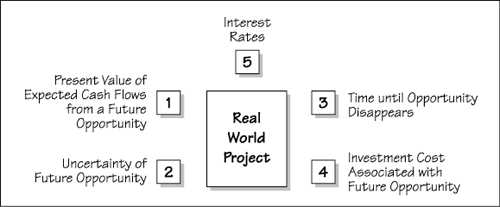From Traditional Valuation to Real Options
| Discounted cash flow is the foundation of modern valuation. It provides a method for capturing the value over time of operational benefits and costs associated with any investment so long as those benefits and costs can be cast in currency terms. We have seen that DCF techniques can deal with both project-specific, or private, risk (through unbiased expected cash flow forecasts) and systematic, or market, risk (through a suitably adjusted discount rate) associated with these operational costs and benefits. DCF alone, however, is not sufficient for capturing all value inherent in a project. DCF can be used to evaluate the operational benefits from business as usual, often the case in a stable environment with well-understood and measurable costs and benefits, but it has little to offer to capture additional business value that is due to flexibility under uncertainty, such as strategic opportunities, learning, and the ability to respond to changing conditions. This orthogonal dimension of value generation requires techniques that can explicitly model active management. Although DCF works well only for deterministic projects with a linear timeline, projects that can be represented by a linear stream of expected cash flows, it does not work well for projects with future decisions that depend on how uncertainty resolves for example, XP projects. For this purpose, we must turn to the intuition and more powerful techniques offered by the theory of option pricing. Option BasicsIn its most general form, an option refers to a future discretionary action. Financial options have been traded for centuries. They date back to seventeenth-century Holland, where tulip options were common. Investors bought options to buy and sell yet-to-be-developed tulip varieties.[1]
Options are a form of derivative [Hull1997]. The value of an option that is, the price to be paid to acquire the option or the value it adds to an existing portfolio of assets depends on the value of an underlying asset. For financial options, the underlying asset can be a stock price, an exchange rate, or a commodity spot price. For real options, the underlying asset is a real asset, typically a stream of future cash flows. A large body of jargon is associated with the options trading industry. Fortunately, we need only the most basic terminology in this chapter. A call option refers to the right, without a symmetric obligation, to buy a risky asset at a preset price called the strike price (a.k.a. exercise price or exercise cost) on or before a future date, called the expiration date (a.k.a. maturity date) of the option.[2]
Figure 43.3 illustrates how an option works, with a simple example. Consider a call option on a stock whose current price is $50, with an expiration date after six months at a strike price of $45. Now let's consider two cases, where the stock price either goes up, to $75, or down, to $35, in six months. If the stock price goes up, the holder of the option exercises the option by buying the stock for $50 and selling it at its market value of $75, making a profit of $30. Otherwise, the holder of the option does nothing, and the option expires worthless. Thus, the option is worth either $30 or nothing at maturity. Figure 43.3. Call option example
Five parameters determine the value of a call option, as shown in Figure 43.4. The arrows next to each parameter indicate whether a higher value of that parameter increases or decreases the value of the option. Figure 43.4. Five parameters determining the value of a call option
Rational ExerciseThe holder of a call option exercises the option only if the price of the underlying asset is above the strike price (the upper straight line in Figure 43.4), to avoid a loss. This practice constitutes a fundamental assumption of option pricing called rational exercise. The rational exercise assumption is behind the behavior of an option's value in response to changes in volatility and the expiration date. As the volatility (total risk) of an asset and time horizon increases, the tendency of the asset's value to move away from its initial value also increases. Rational exercise prevents such an increased tendency to affect the maximum loss, thereby limiting downside risk, but without a symmetrical restriction on the size of the payoff in the case of a positive development. From Financial Options to Real OptionsSo far the discussion has focused on the financial world of stocks and options; but the main interest of this chapter is in the real world of projects and processes that drive them. How do we make the leap from one to the other? The term "real options" was coined in 1977 by Stewart C. Myers of the Massachusetts Institute of Technology (MIT), who first realized that financial option pricing techniques could be applied to the evaluation of projects. The essence of his insight is illustrated in Figure 43.5. The figure maps the five parameters affecting a financial option's value shown in Figure 43.4 to the analogous factors in real-world projects. Figure 43.5. Analogy between financial and real options
The analogy is not quite as simple as Figure 43.5 suggests. In the financial world, parameters such as the current price of a stock (parameter 1 in Figure 43.4) and its uncertainty (parameter 2 in Figure 43.4) are determined by the markets. In the world of real assets, however, it is usually necessary to estimate them through other means often without much information to work from. A full treatment of the relationship between financial options and real options is outside the scope of our discussion, but the main differences are summarized in Table 43.4 at the end of the chapter. For the purposes of this chapter, we take the analogy for granted and move on to the application of options to XP. |
EAN: 2147483647
Pages: 445


